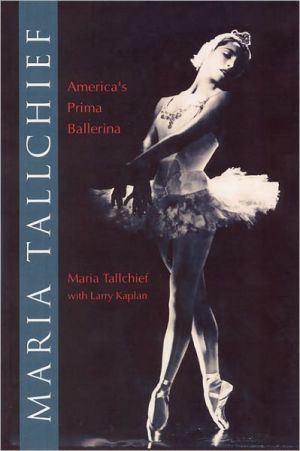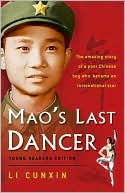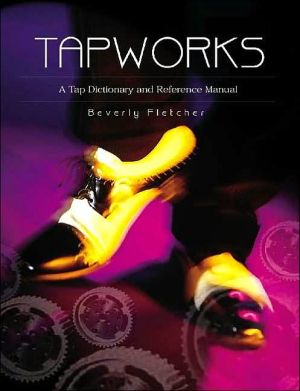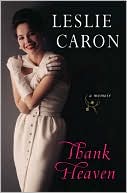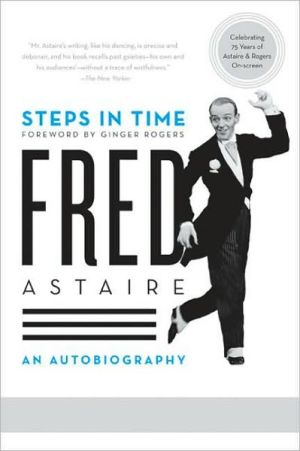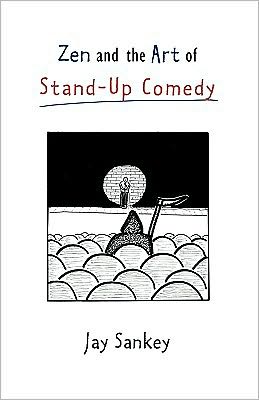Maria Tallchief: America's Prima Ballerina
A fascinating self-portrait of the fairy-tale life of a woman who understood that a committed talent could transform the world around her.\ \ The life of the legendary ballerina Maria Tallchief is told in her own words. Her fascinating memoir is the story of the rigors and pleasures of a dancer's life--an artist's rapid rise to fame that began on an Indian reservation in Oklahoma. Tallchief introduced ballet to the American public and became George Balanchine's wife...
Search in google:
The definitive autobiography in a new paperback edition! "Maria Tallchief and American ballet came of age in the same moment. . . . Her story will always be the story of ballet conquering America. It was and is an American romance."--The New Yorker "Tallchief's autobiography provides us with many stories, insights, even passing remarks that shed light on both this crucial moment in dance history and Balanchine's elusive personality. Tallchief has now given us her definitive and convincing account of Balanchine as choreographer, teacher, husband, friend."--New York Times Book Review Dance Magazine "Her singularity of purpose and devotion to hard work are golden threads throughout the book."
Chapter One \ \ \ My father, Alexander Joseph Tall Chief, was a full-blooded Osage Indian. Six foot two, he walked with a sturdy gait and loved to hunt. The story goes that he could stroll through the woods, rifle in hand, spot a quail or pheasant out of the corner of his eye, point the gun, and shoot the bird without breaking his stride. With his strong aquiline profile, Daddy resembled the Indian on the buffalo-head nickel. Women found him handsome, and when I was young I idolized him.\ My earliest memory of my father is from when I was three. I slept in a second-floor bedroom with my sister Marjorie, who was an infant. One evening when I fell asleep in the living room, Daddy picked me up. Snuggled in his arms, I remember waking as we climbed the stairs. I can still see his dark eyes, his tender smile, his shiny black hair.\ When Daddy was a boy, oil was discovered on Osage land, and overnight the tribe became rich. As a young girl growing up on the Osage reservation in Fairfax, Oklahoma, I felt my father owned the town. He had property everywhere. The local movie theater on Main Street, and the pool hall opposite, belonged to him. Our ten-room, terra-cotta-brick house stood high on a hill overlooking the reservation.\ When my father was a young man, he married a young German immigrant and they had three children—two boys, Alexander (whom everyone called Hunky) and Tommy, and a girl, Frances. They were little children when their mother died. Later, when Ruth Porter, my mother, came to Fairfax to visit her sister, who worked as a cook and housekeeper for my Grandma Tall Chief, Daddy was Fairfax's mosteligible bachelor. Mother must have arrived tired and dusty from her long journey, but from what I'm told there was an instant attraction between them.\ Mother was born in Oxford, Kansas. A determined woman of Scots-Irish blood, she was beautiful, with light brown hair, gray eyes, and delicate features. My tall and lanky father and my tiny mother made an odd couple physically, but they were very much in love. As soon as they married they started a family, and Daddy's children from his first marriage went to live with Grandma Tall Chief, who brought them up in her house at the bottom of the hill.\ I was born in Fairfax in the tiny local hospital on January 24, 1925. The doctor mishandled the forceps, leaving a large red mark on my forehead. Otherwise, I was healthy and normal. They named me Elizabeth Marie after two grandmothers: Eliza Tall Chief, and my Grandma Porter, who'd been named for Marie Antoinette, and with whom I would spend a great deal of time as a child. They called me Betty Marie.\ When Mother became pregnant again, she decided she wasn't going to repeat the experience of giving birth in Fairfax. Her next child, my sister Marjorie, born twenty-one months after me, came into the world in Denver.\ Summers were hot in Oklahoma, and every July and August my parents drove to Colorado Springs, where Daddy played golf and Mother, Marjorie, and I played in the pool of the Broadmoor Hotel. When I was three, Mother took me for my first ballet lesson in the Broadmoor's basement. What I remember most is that the ballet teacher told me to stand straight and turn each of my feet out to the side, the first position. I couldn't believe it. But I did what I was told.\ Ballet lessons were a weekly affair for me, and for Marjorie too, after she was three. Under the spell of Hollywood's Marilyn Miller, Mother thought she was grooming two musical dancing stars. In 1930 Mrs. Sabin, an itinerant ballet teacher from Tulsa, visited Fairfax looking for students. When she heard about the two little girls in the town's most prominent family, she headed for the house on the hill. Before long, Mrs. Sabin had me dancing on pointe and giving recitals.\ But I don't look back on her with gratitude. She was a wretched instructor who never taught the basics, and it's a miracle I wasn't permanently harmed. And my frugal mother was no help. She always bought my toe shoes a size too big so she wouldn't have to buy them too often. Then she'd stuff them with cloth pads so they'd fit and I'd be able to perform the double and triple turns on pointe that seemed to thrill everybody. Of course, Mother didn't really understand the finer points of ballet technique, and I simply did what she asked. I showed an aptitude for dancing and wanted to please. It never occurred to me to say, "It hurts to do that."\ When I was growing up, my Indian Grandma Tall Chief was a majestic figure to me. A typical Indian woman, she wore her hair in a single braid down her back and always had a tribal blanket draped over her shoulders. She and my father were my link to the Osage people. At the time, the tribe lived royally. I was an adult before I heard some of their history.\ In the eighteenth century, the Osage lived in Virginia's Piedmont region, where French and Spanish missionaries converted the Indians to Catholicism. When white people settled the region, the tribe migrated to the valleys near the Ohio and Missouri Rivers. After the West opened up and settlers began arriving, the Osage were forced to move again. They went to Kansas, where they farmed the land and hunted.\ In the nineteenth century, the white man was continually chasing the Indians off their land. As a result, the Osage weren't destined to remain in Kansas. But in 1871, when the United States seized their property, the government had a change of heart, if only for a short period. They paid the Indians for what they took, and with the profits the tribe bought a million and a half acres in northwestern Indian Territory, which later became Oklahoma.\ The Osage had to adjust to the new environment. The land wasn't arable. People couldn't hunt or farm, and times were difficult, but no one starved. Underground lay one of the biggest mineral reserves in North America, and when oil was discovered, everything changed for the Osage. (I never did find out how they kept from starving until they found the oil.)\ Grandma Tall Chief's father, my great-grandfather Chief Peter Bigheart, played an important role in the Osage saga. In 1886 Grandma traveled with him and his relative Chief James Bigheart to Washington. Both men spoke English and were on the council that worked out the provisions of the Osage Allotment Act. The act, which was approved by Congress in 1906, divided the reservation into tracts. Each of the 2,229 members of the tribe received approximately 658 acres, but the allotment of land applied to surface rights only. All mineral rights, the gas and oil that lay underground, were held in common by the tribe. Each Osage received a "headright," meaning that he or she would receive an equal share of all mineral income, which was tax free. An Osage might sell the surface rights to his land, but never a "headright." That was illegal. The only way an Osage could lose his "headright" was to die.\ By 1925, even though the Osage had become rich, they, like all Indian tribes, were subject to government edicts, which were designed to destroy tribal customs. Indian ceremonies were banned and tribal languages forbidden. The Osage and many other Indian nations kept their culture alive by holding ceremonies in remote corners of the reservation Marjorie and I were thrilled when, together with Grandma Tall Chief, Daddy drove us to the location.\ The powwow was a journey to the past. The Indians wore traditional tribal clothing made of animal hide, elaborate headdresses, tribal blankets, beads, silver jewelry, and moccasins; they clustered in groups, sitting on the ground in semicircles, smoking pipes. During conversations, they stared off into space, never looking at the person they were talking to. It was as if they could feel the person instead of seeing him, and that was preferable to visual contact.\ At the powwow there was dancing, and Indian music was played on tom-toms. Osage women didn't really dance. Instead they formed a circle around the men and did a little side step, shifting their weight from one foot to the other in time to the drumbeat, covering very little space. Men did the active dancing, stomping their feet on the ground to the tom-tom rhythm. Accompanying themselves on the drums, they also sang songs that told fables about the history of the tribe. The rhythm of those songs has stayed with me.\ My brother Jerry was born with rickets, a vitamin D deficiency in children that can result in disordered bone growth. The condition may have been indicative of some other abnormality, but Jerry was treated with vitamin D and expected to lead a normal childhood. When he was four, however, a serious accident occurred.\ My father kept horses in a big red barn behind our house. They were always running loose in the pasture where my half-brothers rode them. Like everyone in Fairfax, Jerry lived on a horse, and he was always around them. One day, a year or so after I was born, he was out in the pasture playing and one of the steeds kicked him in the head.\ Competent medical practitioners were in short supply in Fairfax, and X-ray facilities were nonexistent. Jerry seemed to recover, but he had difficulty learning to read. Mother tried teaching him. She'd go over the letters of the alphabet and vocabulary words with him, repeating the words so often that before long, sitting nearby and overhearing her, I learned to read myself.\ I often wonder if Mother's disappointment in Jerry is what caused her to turn her attention to Marjorie and me, making it so important for her that we succeed. Mother devoted her life to her husband and her daughters. Her fortitude and strength of mind, values she instilled in my sister and me, helped us achieve what we accomplished in life.\ When I was five, Mother enrolled me in Sacred Heart Catholic School, which was down the hill from our house in the opposite direction of Grandma's, almost at the end of our driveway. The teachers there, impressed by my reading ability, placed me in a class two grades ahead of the other children my age.\ I was a good student and fit in at Sacred Heart. But in many ways, I was a typical Indian girl—shy, docile, introverted. I loved being out doors and spent most of my time wandering around our big front yard where there was an old swing and a garden. I'd also ramble around the grounds of our summer cottage hunting for arrowheads in the grass. Finding one made me shiver with excitement. Mostly, I longed to be in the pasture, running around where the horses were, but as a result of Jerry's accident I was never allowed there by myself. These inaccessible rolling distances, green and lush in summer, seemed magical to me.\ As a little girl, however, I didn't have much time to dream. When it was discovered that I had absolute, or perfect, pitch Mother insisted I play the piano. Most of my day was taken up with schoolwork, and music and ballet lessons. I remember practicing ballet one afternoon with Marjorie, when my half-sister, Frances, and my cousin Pearl Bigheart appeared at the window of our house, giggling and making fun of what we were doing.\ Cousin Pearl was an orphan, and our family was concerned for her well-being. When she was small, her house had been firebombed and everyone inside killed, murdered for their headrights. Pearl's situation was not uncommon. In the 1920s, villainous white men married into Osage families, then poisoned their wives or shot them in order to get their money, another example of the slaughter of Indians that is a notorious chapter of U.S. history.\ This was called the Osage Reign of Terror, and it began in 1921 when an Osage woman was found with a bullet in her head at the bottom of a canyon. William K. Hale, a prosperous rancher, who was responsible for this death and many others, was also responsible for the murder of Pearl's relatives. He had persuaded his cousin Ernest Burkhart to marry one of Pearl's aunts. After the wedding, Burkhart poisoned her and inherited her headright.\ But he was greedy. He and Hale made plans to grab all the family's headrights by dynamiting the house and killing everyone inside. Luckily, Pearl was visiting Grandma Tall Chief when the blast occurred, and she escaped with her life. Grandma was raising her now. The irony was that because of the carnage, Pearl now owned more headrights than anyone. She was one of the richest people in the tribe.\ When Hale and Burkhart realized what had happened, they developed a new scheme and tried stealing Pearl's fortune with a fake life insurance policy naming Burkhart as beneficiary. Insurance scams were another means of robbing the Indians. But Grandma was too brave and too smart to be taken in. She couldn't read or write, and used to sign important papers with an X, but she knew what was happening. When Burkhart and Hale came knocking on her door, she stood up to the killers and sent them away.\ Eventually, the FBI was brought in to investigate. By 1926 the agency had gathered enough evidence to indict Burkhart and Hale and convict them for murder. The Reign of Terror had come to an end but not before more than sixty Osage Indians had been slaughtered.\ Despite her dream of her daughters becoming musical film stars, Mother also believed, because of my musical gifts, that I was destined for a career as a concert pianist. Deep down a strict disciplinarian, Mother started me in lessons at age three, and made me practice the piano religiously. But I also practiced dancing.\ Once Marjorie grew older, Mrs. Sabin created routines we performed—part ballet, part vaudeville—to "Stars and Stripes Forever" and "Glow Worm" at community events, county fairs, and rodeos. For "Glow Worm," I wore a costume my mother made by putting turquoise feathers onto her peach negligee. In "Stars and Stripes Forever," an American flag was sewn into the lining of my cape.\ Whenever a rodeo was held in Fairfax or Ponca City or Grey Horse or Pawhuska, the Tall Chief girls were always asked to dance Mrs. Sabin's routines. Rodeos petrified me. Long-horned bulls lumbered by so close behind the grandstand I was sure I'd get gored waiting to go on. I was happier performing at my father's movie theater.\ Dancing with Marjorie made up for my distress at rodeos. We weren't competitive. As dancers we were complete opposites. She was much more limber and could put her leg up around her head without any difficulty. My extension wasn't nearly as high. Marjorie's problem was holding herself together and mine was pulling myself out and stretching.\ My sister and I were best friends. Mother dressed us alike, and at times it was hard to tell us apart. While Mother was so preoccupied with my brother Jerry, I became like Marjorie's parent. People had difficulty understanding her because she couldn't pronounce her Ls and her Rs. "What'd she say?" they'd ask, and I'd have to interpret.\ Like many in the wealthy Osage tribe, Daddy had never worked a day in his life. He was a modern-day Osage in another respect. He drank. His drinking ran in cycles, mostly when the oil royalties check arrived. Royalties were paid quarterly for the sum of several thousand dollars, a large amount for the time but considerably less than it had been because by 1930 the Osage oil supply was being depleted.\ Mother and Daddy often argued about money. Since the income he received from his real estate holdings was negligible, the family lived on the oil checks. Usually he was patient, always trying to calm Mother's fears, but the arrival of the oil money set him off. He'd pocket the check and cash it, then disappear for a week at a time. Mother would become frantic. She was afraid that Daddy would spend all the money, or worse, injure himself or become ill. She suffered terribly during Daddy's binges, never knowing her husband's whereabouts or what he was doing.\ When Daddy returned home, she'd sag with relief. On one occasion she confronted him.\ "Alex, where have you been? Have you spent all our money?" Daddy tried ignoring her, but she harped on him. "How do you expect us to live? You don't have a job—"\ "Don't bother me, Ruth," he shouted. "I'm tired of hearing about it."\ "I have three children to raise, a household to run—"\ "So what?!" he cut her off, his eyes burning with anger. With a violent gesture, he shoved a stack of magazines off a table onto the floor.\ Daddy could be very belligerent. When he was angry, the walls seemed to shake and the air seemed to fill with the thunder of his fury. He towered over Mother. She was tiny next to him, and vulnerable. Marjorie and I, hearing their terrible arguments, became terrified. We'd run all the way down the hill to Grandma Tall Chief's, interrupt whatever she was doing, and beg her to come up to the house to reason with her son before it was too late. My sister and I imagined the most horrible violence.\ Although Daddy never once struck Mother, when he was on a rampage it was very frightening. Perhaps the pressure of raising a family, or of not having enough money to do so, made him drink. After Marjorie and I moved out of the house and were leading successful lives, he gave up alcohol. But while we were growing up, he was often unbearable.\ Mother endured father's alcoholism. She was helpless to change it and never judged him. She loved him in spite of his flaws. When the famous novelist Edna Ferber was writing her book Cimarron, which is set in Oklahoma, she tried to interview Daddy. Cimarron concerned the Osage and their headrights, and I think Ferber believed that Daddy had information she needed. But my mother wouldn't let him see her. She was jealous. Daddy was extremely handsome, attractive to women. Although Ferber wasn't known for her good looks, I believe Mother was afraid that Daddy would fall in love with the sophisticated novelist and abandon us.\ My mother grew increasingly dissatisfied with our life in Fairfax. To her it was a place where people wasted their lives, where her husband destroyed himself with drink, where her daughters remained in small-town music and ballet lessons that never would amount to much, and where her son's injury had ruined his life.\ Nothing Mother did for Jerry seemed to help. When she introduced him to the violin, it was a catastrophe. He became violent and threw the instrument at the teacher. He was always difficult to discipline. My sister Marjorie remembers Jerry making sexual advances. Apparently when it happened we were in the kitchen, and I grabbed a knife.\ "Don't you dare come near me!" I warned him, and he ran away.\ I have no recollection of any overt action on his part, but I do remember telling him to stop bothering me. I may have just lost my temper because he was being a nuisance.\ As Jerry grew older even Daddy couldn't handle him, and my parents were forced to send him away to military school. After he graduated, Jerry returned to Fairfax and lived there quietly, never really holding a job.\ Although her frustration with her son may have contributed to Mother's restlessness, her eagerness to leave Fairfax behind may also have grown out of her ancestry. She was from a family of true pioneers. She longed for more than our town and those shrinking oil checks.\ In 1933 Mother could wait no longer. To her, Los Angeles was a giant city that held a future with glittering promise. Daddy raised no objection to our leaving. L.A. promised a dreamlike climate in which he could play golf all year long, in truth, a powerful incentive for moving. We crowded into Daddy's maroon Pierce-Arrow and set off into our future.\ Hours in the car passed with little to do other than gaze out the windows as the world flashed by. When we reached California, the expanse of orange groves hypnotized me with its order and brilliance of color. The Pacific Ocean seemed to be everywhere, lurking beyond curves in the road, hiding between gaps in the trees. After the ponds, creeks, and rivers of Oklahoma and Colorado, the immensity of the ocean terrified me.\ We reached Los Angeles after an overnight stay with Mother's relatives in San Diego. Without knowing where we would settle, we just drove on. In the Wilshire District Daddy stopped for gas. Marjorie and I were restless and hungry, so Mother took us to the local drugstore. We ordered hamburgers and soda pop at the fountain, and we sat on red-leather stools while waiting for them to be served. Mother asked the druggist if he knew a good dancing school in the neighborhood.\ "Yes, I do," the man told us. "Ernest Belcher's."\ That was it. An anonymous man in an unfamiliar town decided our fate with those few words. After we devoured our hamburgers, Mother walked out to the car and told Daddy that she wanted to live right there, in a neighborhood where we had only stopped to fill the gas tank.\ In California, public school teachers seemed to understand that an eight-year-old had no business being in the fifth grade, and they placed me back in the third grade in what they called an Opportunity Class, an advanced program. Opportunity Class or not, I was still way ahead. With nothing to do, I often wandered around the school yard by myself.\ Ballet school was different. There I had to work. At Ernest Belcher's studio, in addition to ballet, pupils studied tap, acrobatics, and Spanish dancing. So Marjorie and I had it all. Elissa Cansino, who taught Spanish dancing, was a wonderful teacher, and I became expert with the castanets. We even studied tumbling, and for hours on end I had to practice walkovers—which Marjorie did so easily—until I wanted to scream. I hated the tumbling classes and worked myself into such a frenzy over them that Mother let me stop, but years later I'd be able to put all I learned there to good use.\ Mr. Belcher understood, however, that it was not character dancing technique Marjorie and I lacked. A character dancer performs national or folk dances, such as mazurkas and polkas, which are not performed on pointe. My sister and I were deficient in the basics of ballet technique. Our training shocked him.\ "Your daughters have been put on pointe way, way too early, Mrs. Tall Chief. It's a miracle they haven't injured themselves."\ He insisted we go back to the beginning.\ We were fortunate. Mr. Belcher was an excellent teacher who had studied the principles of Enrico Cecchetti, the Italian ballet master who worked in Russia at the turn of the century. A small man with a tiny mustache, Mr. Belcher sat when he taught; even so, he would demonstrate in his chair, and that fascinated me. I was eager to learn.\ Mr. Belcher was a family man, and sometimes in class his daughter Marge would study with us. She was a beautiful, friendly young girl, and I liked her. When she grew up, she and her husband, Gower Champion, became film stars.\ While Marjorie and I were studying at Mr. Belcher's, our family moved from the Wilshire District to a house on Rexford Drive in Beverly Hills. Public schools in Beverly Hills were academically superior to those in the rest of the city, and Mother made the move so we could attend a public school. But at Beverly Vista School I was made to feel different.\ Some of the students made fun of my last name, pretending they didn't understand if it was Tall or Chief. A few made war whoops whenever they saw me, and asked why I didn't wear feathers or if my father took scalps. After a while, they became accustomed to me, but the experience was painful. Eventually, I turned the spelling of my last name into one word. Everything in school was in strict alphabetical order and I wanted to avoid confusion.\ Marjorie and I progressed at Mr. Belcher's, appearing in recitals there and at Boy Scout jamborees. Later, a man Mother met through the school convinced her that since Marjorie and I were part Indian, we should do a Native American dance. She was all for it, and we performed it at county fairs and the Eastern Star Lodge benefits. Mother added her own touch, however, and spent hours putting our hair up in Shirley Temple curlers.\ The routine we performed made us both self-conscious. It wasn't remotely authentic. Traditionally, women didn't dance in Indian tribal ceremonies. But I had toe shoes on under my moccasins, and we both wore fringed buckskin outfits, headbands with feathers, and bells on our legs. We'd enter from opposite wings, greet each other, and start moving to a tom-tom rhythm. The performance ended with my going center stage and twirling around, doing what was called signal turns while Marjorie made a circle around me performing the no-handed back-flip somersaults that she was so good at.\ In the end, we stopped doing the routine because we outgrew the costumes. I was relieved when we put those bells away for good.\ When I was twelve years old and Marjorie was ten and a half, we went to a new ballet teacher. A ballet mother at Mr. Belcher's told Mother that the great Bronislava Nijinska had opened a studio near Beverly Hills, and even though I'm not sure Mother knew who Nijinska was, she decided to have Marjorie and me study with her. Without telling Mr. Belcher, she enrolled us at her school.\ The new studio seemed no different from Mr. Belcher's. Little girls were changing into leotards, and mothers were milling about gossiping. A small, rotund gray-haired woman with great, big, luminous green eyes was counting heads. I thought she was the secretary.\ When the pianist entered and bowed to her, the little gray-haired woman clapped her hands, a signal for students to take their places at the barre. In a flash, I realized who she was. By then, there was no mistaking Madame Nijinska. Everyone at the school was in awe of her.\ Bronislava Nijinska was the sister of the fabulous Vaslav Nijinsky, and like him a graduate of the Imperial Theatre School in St. Petersburg, Russia. She too had danced at the Maryinsky Theatre and with Sergei Diaghilev's Ballets Russes in Europe, and she was also a choreographer. Two of her ballets, Les Noces and Les Biches, were classics.\ When we started working I saw at once that Madame's class was rigorous. Students weren't allowed to slouch at the barre or hang on it haphazardly, and we had to be conscious of each exercise. After we finished doing a step, we had to walk to the side and stand still with perfect posture until it was time to take our places for the next exercise. At the same time, Madame indicated that we should watch our fellow students closely and listen to every correction.\ Because her English was practically nonexistent Madame Nijinska rarely spoke. She didn't have to. She had incredible personal magnetism and she radiated authority. Most of the time she demonstrated. It was hard to imagine her as a ballerina, but how she moved! Her footwork was phenomenal. She jumped and flashed around the studio. I was under her spell. The likes of Madame Nijinska were something I had never seen before.\ Every day she dressed in the same pants and plain top; her ballet slippers had a slight heel. In her pointe class, we'd have to repeat steps over and over, learning how to balance and how to hold a position so that our entire backs were being utilized. She was very precise. In first position, elbows had to be held a certain way and the little finger had to touch the front of the thigh. If Madame could come by and move someone's elbow, the position was wrong.\ She was insistent on port de bras, and she told us the reason her brother could jump so high and hover in the air so long was because of the control he had over his abdominals. It was from Madame Nijinska that I first understood that the dancer's soul is in the middle of the body and that proper breathing is essential.\ Even though she wasn't verbal, Nijinska knew how to get her point across. She communicated with a firm tap on the shoulder. Her husband, Nicholas Singaevsky, sometimes translated, but his English wasn't much better than hers.\ "Madame say you look like spaghetti," he'd explain, and the message was understood. He'd also expound her philosophy. "Madame say when you sleep, sleep like ballerina. Even on street waiting for bus, stand like ballerina."\ So we didn't concentrate only for an hour and a half a day on what was being taught. We lived it, and I was beginning to understand just how hard I was going to have to work if I wanted to be a dancer. I was small-hipped and had to work hard for the turnout essential to ballet. But since I was eager to develop, when I was in Nijinska's class I never took my eyes off her, never looked away, even when she was helping another girl.\ The force of Madame Nijinska's personality, and her unwavering devotion to her art, helped me to understand that ballet was what I wanted to do with my life. In her studio I became committed to becoming a ballerina, and Madame understood I was serious. She saw that I was very musical and had good proportions, and she paid a great deal of attention to me. She was always giving me corrections, a sign of her interest, and little by little she began treating me like her protegee.\ In all, I think the importance of the five years of training I had with her can never be overestimated. I was in the right place at the right time. Before Nijinska, I liked ballet but believed that I was destined to become a concert pianist; at age twelve I had given a recital in which I played selections by Bach and Mozart on piano in the first half and danced during the second. Now my goal was different. Two strong women, my mother and my teacher, were directing my destiny, and I loved them both.\ In 1938 the Ballet Russe de Monte Carlo's arrival in Los Angeles was a momentous event in my world. With a slew of other adolescent girls, Marjorie and I flocked to performances, returning several times. We saw Giselle and Balanchine's Serenade, but Gaite Parisienne, Ballet Russe's signature piece, so romantic and colorful, made the strongest impression. Choreographed to operetta music by Jacques Offenbach, the ballet was a frothy celebration of fin-de-siecle European ambience, filled with high spirits and convivial dancing. I was captivated.\ More thrilling than the performances, however, was when the Ballet Russe stars I worshiped from afar arrived at Madame Nijinska's to take class and pay their respects. I couldn't get over the sight of those magnificent artists in my teacher's studio. Frederic Franklin, Mia Slavenska, George Zoritch: They were all there. And the biggest star of all, Alexandra Danilova, gave Nijinska roses when she entered the studio, and executed a reverence as she presented them.\ It wasn't only at Nijinska's, however, that I was learning what it meant to be a professional. Ada Broadbent, a one-time dancer with Fauchon and Marco's Hollywood Symphonic Ballet, used to choreograph dances for the Los Angeles Civic Light Opera, and Marjorie and I danced for her. Broadbent also staged extravaganzas of her own—a mix of vaudeville, show business, and classical ballet—that featured music and dancing on themes like "Dance Through the Ages." In one, Marjorie and I danced a jazzy number to the tune of the "Black Bottom." We also danced the "Waltz of the Flowers" and something called "South American Rumba."\ Broadbent choreographed the first pas de deux I ever danced, to music from The Vagabond King for the Los Angeles Civic Light Opera. Paul Godkin, who later joined Ballet Theatre, was my partner. We did it in one of Broadbent's productions at the Philharmonic Auditorium. We also appeared at the Shrine Auditorium, where Milton Berle was on the bill.\ When I was about fifteen years old, Madame Nijinska decided to stage three of her ballets, Etude, Chopin Concerto, and Bolero, at the Hollywood Bowl, which is a huge outdoor amphitheater in the Hollywood hills. The music she was using for Chopin Concerto, the Piano Concerto in E Minor, was special to me as I was playing it on the piano. That I was familiar with the concerto seemed like a good omen.\ One big role was being performed by a lovely dancer named Cyd Charisse. Cyd, who would later become a movie star, was a stunningly beautiful girl who had already performed professionally with the Original Ballet Russe. When rehearsals began, instead of being cast opposite her in the other lead, I was put in the corps de ballet. I was hurt and humiliated. I couldn't understand what was happening. Madame Nijinska had always paid so much attention to me. What was wrong? Didn't she love me anymore? Wasn't I her favorite? I was miserable, and showed it. Not being used to dancing in the ensemble, I stood there in the line of girls without putting any energy or feeling into what I was doing.\ Mother understood the problem. "You have to show that you want to dance with all your heart, Betty, even in the corps. You shouldn't just expect a role to be handed to you."\ The next day, I put everything into rehearsing, and shortly thereafter was rewarded with the other leading part. I was ecstatic. Now I couldn't stop practicing, and went over the steps day and night.\ Marjorie was also in the ballet, in the ensemble. The night of the performance we arrived at the Bowl about fifteen minutes before curtain. Mother drove us but got us there late. Uninitiated in the rites of professional theater, she didn't realize we were supposed to arrive two hours early to put on makeup and warm up.\ At rehearsal earlier in the day we'd seen how slippery and hard the floor was. Canvas cloths had been laid down for the performance, but we arrived too late to try them out. Apprehensive, I stood in the wings waiting for my cue, and when I heard it I made my entrance. As soon as I started dancing, I slipped. I recovered quickly and went on, but I was shaken.\ Madame Nijinska was watching from the wings. It was the only time I had seen her in street clothes. When I made my first exit, I went over to her, a stricken look on my face. But she made nothing of the incident.\ Performing the ballet was different from dancing in the Broadbent extravaganzas. The choreography was extremely difficult. I had to perform double fouettes, a bravura step in which a whipping motion of the free leg propels the dancer around the supporting leg, with the most precise control. (The thirty-two fouettes the ballerina performs in Swan Lake, Act Three, is one of the most famous passages in the ballet.) And dancing next to Cyd, the most beautiful girl I'd ever seen in my life, with lovely long legs and sculptured feet, didn't help my confidence. But once I recovered my nerves, I attempted to perform as Madame Nijinska had taught me.\ Madame Nijinska was my ballet teacher all through my high school years, and I worked hard to absorb everything she taught me and to do everything she said. Occasionally, however, I studied with other celebrated artists who came to Los Angeles to teach. One of them, David Lichine, a respected dancer-choreographer, made a favorable impression on Mother. His wife, Tatiana Riabouchinska, a beautiful Russian, had been one of the famous "baby" ballerinas Balanchine had created in Paris in the 1930s, and was also a star of Colonel de Basil's Original Ballet Russe. She seemed to epitomize all the qualities Mother admired. She was poised, ladylike, quite formal, and a wonderful dancer.\ In my senior year, another star came to Los Angeles. Mia Slavenska, the beautiful Yugoslavian ballerina who danced with the Ballet Russe de Monte Carlo, was teaching at a local studio and sometimes we went there to study with her.\ Like Nijinska, Slavenska seemed to favor me and told my mother she was going to arrange an audition for Serge Denham and his committee when they came to town.\ Mr. Denham was the head of the Ballet Russe de Monte Carlo, and on the appointed day he appeared at Slavenska's studio with Frederic Franklin and a few others I didn't recognize and watched her teach her class. When it was over, no one said anything to me or offered me any contract. But Mr. Denham did tell my mother, "She's very good. I'd like to see her after she graduates from high school."\ That seemed like a vague promise and I was a little disappointed, but I didn't let it bother me. A part of me was determined to enter college. Yet, in an unexpected turn of events, my father didn't like the idea.\ "You know, I've paid for your lessons all your life and now it's time for you to find a job," he said.\ I was surprised, but ages seventeen through twenty are important years for a dancer. If I was going to be a ballerina it was time to get started. I auditioned for an MGM movie musical called Presenting Lily Mars, a Judy Garland vehicle. It wasn't much of a job; I was little more than a dancing extra, but I liked being on the set. Judy Garland worked hard and was full of energy. Listening to her sing on playback was a thrill. Daddy was proud.\ As soon as my part in the film was completed I started thinking about what else I could do. I knew I didn't want to dance in the movies for a living. It wasn't gratifying. I was trying to figure out how to earn money when my mother startled me with a proposition.\ "You know, Betty Marie, Tanya Riabouchinska is going to New York to join David Lichine and dance at Ballet Theatre. She asked me if you'd like to go along with her for the summer. She said she'd be perfectly willing to take you. I think it's wonderful. When you're in New York you can make an appointment with Mr. Denham and audition again for the Ballet Russe."\ Mother was fired with enthusiasm for my dancing dream. It seemed a little out of character. She knew I was no longer practicing piano two hours a day. Perhaps she was beginning to understand my dreams. Most of all, the visit in New York must have seemed like a great way for me to spend the summer. She had absolute faith in the Lichines and knew they would look after my welfare. After I got over my surprise, I agreed to go. I still wanted to do whatever would please her.\ Mother and I went out and bought a huge fortnighter suitcase, which I packed so full that we had a hard time closing it. I'm not sure what I put into it or why I thought I needed such a huge bag. I could hardly lift it off the ground. A few days later, Daddy drove us all to the terminal Marjorie, still in high school and studying with Nijinska, was excited on my behalf, certain that in New York I would be able to realize the dream we both shared of becoming a ballerina. After saying good-bye to Marjorie, Daddy, and Mother, I boarded the train with Riabouchinska I was on my way.\ A Life Wild and Perilous\ MOUNTAIN MEN AND THE PATHS TO THE PACIFIC\ \ \ By ROBERT M. UTLEY\ \ Henry Holt and Company\ Copyright © 1997 Robert M. Utley. All rights reserved.\ TAILER
\ Dance Magazine"Her singularity of purpose and devotion to hard work are golden threads throughout the book."\ \ \ \ \ Publishers Weekly - Publisher's Weekly\ Tallchief, whose father was a hard-drinking, oil-rich Osage chief, was born on an Oklahoma reservation. But when Tallchief was eight and had already outgrown the limited ballet instruction available in Oklahoma, her strong-willed, Scotch-Irish mother moved the family to Los Angeles, where the girl studied with Ernest Belcher and Bronislava Nijinska. At age 17, Tallchief joined the Ballet Russe de Monte Carlo and there met choreographer George Balanchine, whom she married in 1946. The marriage dissolved a few years later, but she remained devoted to Balanchine and, until her retirement in 1966, was a leading ballerina in his New York City Ballet. In this lackluster autobiography, Tallchief records all the details of her background and training and traces her career, her three marriages and her relationships with her dance partners, especially Andr Eglevsky and Erik Bruhn. Her accounts of the evolutions of the ballets in which she starred and of Balanchine's working methods will be of interest to balletomanes, but the book, written with Kaplan, who has also coauthored biographies of Merrill Ashley and Edward Villela, lacks the fire and excitement that characterized the dancing of one of the great ballerinas of this century. Photos not seen by PW. (Apr.)\ \ \ Library JournalLivingston, a journalist and former dancer, has written the first authorized biography of Maria Tallchief a 1996 Kennedy Center honoree, Marjorie Tallchief, Rosella Hightower, and Yvonne Chouteau. The book celebrates the accomplishments of these women, who share a state Oklahoma, a profession ballet, and a heritage Native American. Livingston draws largely from interviews she conducted with the dancers, who describe their rise to fame, the touring life, and the complexities of combining professional and personal lives. The book successfully conveys the positive attitudes that played a significant part in each dancer's success, but it lacks the detail and objectivity readers have come to expect of biographies and dance histories. Ultimately this is light, enjoyable reading for balletomanes. Focusing on her remembrances of her years with choreographer George Balanchine, Tallchief's autobiography is more revealing. She met Balanchine at the start of her career, when she was with the Ballet Russe de Monte Carlo and Balanchine was about to form a company that would become a precursor to the New York City Ballet. Tallchief subsequently became Balanchine's wife, muse, and prima ballerina, and, though the marriage was short-lived, their artistic partnership endures in Balanchine's works created for Tallchief. She also writes about other stars, but the memoir sparkles when she recalls the subtlety and detail of a movement or the beauty of a musical phrase. Kaplan has coauthored biographies of Merrill Ashley and Edward Villela. Wholly satisfying fare for the seriously interested.Joan Stahl, National Museum of American Art Lib., Washington, D.C.\ \ \ \ \ Kirkus ReviewsThe tastefully yet candidly told life story of one of America's most gifted dancers, a former wife of George Balanchine.\ Tallchief was born Elizabeth Marie Tall Chief in 1925, to an alcoholic but loving Osage Indian father and a white mother in small-town Oklahoma. When the family moved to Los Angeles, she began studying ballet with Bronislava Nijinska ("It was from Madame Nijinska that I first understood that the dancer's soul is in the middle of the body"). Tallchief joined the Ballet Russe while still a teenager and changed her name to Maria at the suggestion of Agnes de Mille. She first worked with Balanchine in 1944, when he was hired as a choreographer by the Ballet Russe. A year later, the much older man of few words shocked her by saying casually that "I would like you to become my wife." Although this collaboration between Tallchief and ghostwriter Kaplan (Prodigal Son, 1992) does not include much about Tallchief's firsthand view of Balanchine's revisionary classical technique, the book abounds with droll tales and with detailed descriptions of her roles in Balanchine's The Firebird, The Nutcracker, Orpheus, and Sylvia, among others. She chronicles, too sketchily, doings among her famous fellow dancers at the New York City Ballet. Her marriage to Balanchine ended in an annulment. Tallchief is equally frank and lively in describing her career after Balanchines, including an affair with the nubile Rudolf Nureyev. ("I taught him the twist . . . he picked it up right away.") She also offers penetrating, if tactful, criticism of NYCB's post-Balanchine regime: "The irony of George's remark that `ballet is woman' is that today most of the companies in the world are being run by men . . . the contribution former Balanchine ballerinas can make, ballerinas who worked directly with George and who created their roles, isn't being valued, not even in George's own company."\ What would happen, one wonders, if this remarkable woman were running things?\ \ \
